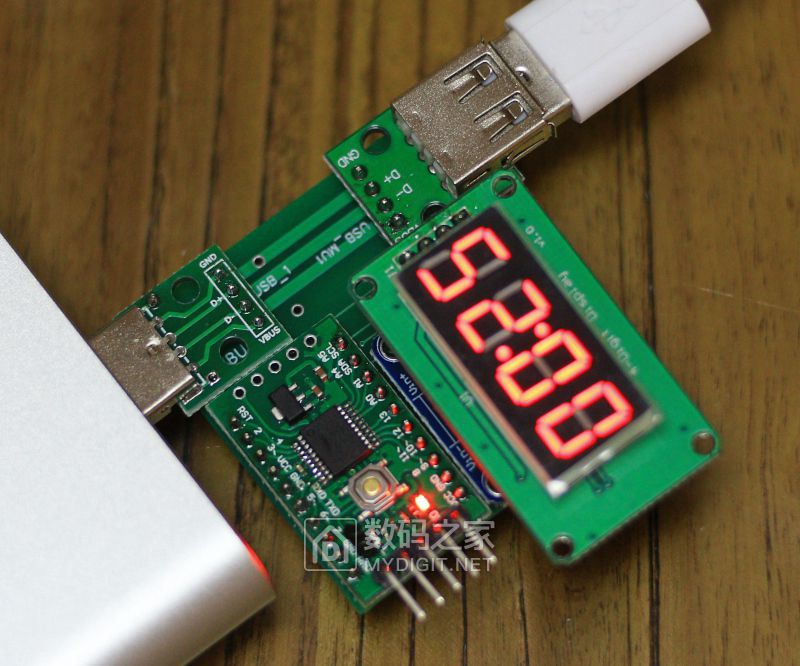|
|
爱科技、爱创意、爱折腾、爱极致,我们都是技术控
您需要 登录 才可以下载或查看,没有账号?立即注册
x
普通的USB电流表多数都显示不了《10MA的电流
虽然我买了个贵的,但是贵了就不舍得用了。。。
于是TB了模块 搞个便宜的。。。
lgt8f328p -- 3.5
USB 公母头 1块钱
5块钱打板(5张)
INA219 5块
数码管 1.5
不到20块钱或者说10块钱左右。。。。。。
要我自己焊洞洞的话,肯定没这么小,虽然比USB的电流表还是要大不少。但是 我觉得够了。。。
要认同自己的能力:lol:

- /*
- ReadAnalogVoltage
- lgt8f328p读取电压 Wemos TTGO XI 8F328P-U Board
- adafruit / Adafruit_INA219
- */
- // the setup routine runs once when you press reset:
- #include <math.h >
- #include "TM1637.h"
- #include <Adafruit_INA219.h>
- Adafruit_INA219 ina219;
- #define CLK 10//pins definitions for TM1637 and can be changed to other ports
- #define DIO 9
- TM1637 tm1637(CLK, DIO);
- unsigned char ClockPoint = 1;
- int sensorValue = 0;
- unsigned char hour = 0;
- unsigned char minute = 0;
- int8_t TimeDisp[] = { 0x00, 0x00, 0x00, 0x00 };
- //float shuntvoltage = 0;
- // float busvoltage = 0;
- float current_mA = 0;
- // float loadvoltage = 0;
- // float power_mW = 0;
- void TimeUpdate(void) { int sensorValuesa=current_mA*10;
-
- if (ClockPoint) {
- tm1637.point(POINT_ON);
- // Serial.println(sensorValuesa / 1);
- // delay(100);
- // tm1637.set(BRIGHT);
- TimeDisp[0] = sensorValuesa / 100 / 10;
- TimeDisp[1] = sensorValuesa / 100 % 10;
- TimeDisp[2] = sensorValuesa % 100 / 10;
- TimeDisp[3] = sensorValuesa % 100 % 10;
- }
-
- }
- void setup() {
- // initialize serial communication at 9600 bits per second:
- //Serial.begin(9600);
- uint32_t currentFrequency;
- // Initialize the INA219.
- // By default the initialization will use the largest range (32V, 2A). However
- // you can call a setCalibration function to change this range (see comments).
- ina219.begin();
- // To use a slightly lower 32V, 1A range (higher precision on amps):
- //ina219.setCalibration_32V_1A();
- // Or to use a lower 16V, 400mA range (higher precision on volts and amps):
- ina219.setCalibration_16V_400mA();
- tm1637.init();
- tm1637.set(BRIGHT_TYPICAL); //BRIGHT_TYPICAL = 2,BRIGHT_DARKEST = 0,BRIGHTEST = 7;
- tm1637.point(POINT_OFF);
- analogReference(INTERNAL2V56); //use internal 1.1v as Avref
- //analogReference(EXTERNAL); //使用外部基准
- //analogReference(type)
- //描述
- //配置用于模拟输入的基准电压(即输入范围的最大值)。选项有:
- //DEFAULT:默认5V(Ocrobot控制板为5V)或3.3伏特(Ocrobot控制板为3.3V)为基准电压。
- //INTERNAL:在ATmega168和ATmega328上以1.1V为基准电压,以及在ATmega8上以2.56V为基准电压(Ocrobot Mega无此选项)
- ////INTERNAL1V1:以1.1V为基准电压(此选项仅针对Ocrobot Mega)
- //INTERNAL2V56:以2.56V为基准电压(此选项仅针对Ocrobot Mega)
- //EXTERNAL:以AREF引脚(0至5V)的电压作为基准电压。
- //参数
- //type:使用哪种参考类型(DEFAULT, INTERNAL, INTERNAL1V1, INTERNAL2V56, INTERNAL4V096 或者 EXTERNAL)。
- //返回
- //无
- uint32_t guid = (GUID3 << 24) | (GUID2 << 16) | (GUID1 << 8) | GUID0; // 给guid赋值唯一ID
- //Serial.println(guid); // 串口输出唯一ID
- delay(2000);
- }
- // the loop routine runs over and over again forever:
- void loop() {
- // read the input on analog pin 0:
- //sensorValue = analogRead(A0);
- // shuntvoltage = ina219.getShuntVoltage_mV();
- // busvoltage = ina219.getBusVoltage_V();
- current_mA = ina219.getCurrent_mA();
- // power_mW = ina219.getPower_mW();
- // loadvoltage = busvoltage + (shuntvoltage / 1000);
- // Serial.print("Bus Voltage: "); Serial.print(busvoltage); Serial.println(" V");
- // Serial.print("Shunt Voltage: "); Serial.print(shuntvoltage); Serial.println(" mV");
- // Serial.print("Load Voltage: "); Serial.print(loadvoltage); Serial.println(" V");
- // Serial.print("Current: "); Serial.print(current_mA); Serial.println(" mA");
- //Serial.print("Power: "); Serial.print(power_mW); Serial.println(" mW");
- // Serial.println("");
- delay(200);
- // Convert the analog reading (which goes from 0 - 1023) to a voltage (0 - 5V):
- //float voltage = sensorValue * (2.56 / 4096.0);
- // print out the value you read:
- //Serial.print(sensorValue);
- //Serial.print(' ');
- //Serial.print(cbrt(sensorValue));
- //Serial.print(' ');
- //Serial.println(voltage);
- //delay(1000);
- TimeUpdate();
- tm1637.display(TimeDisp);
- }
|
打赏
-
查看全部打赏
|